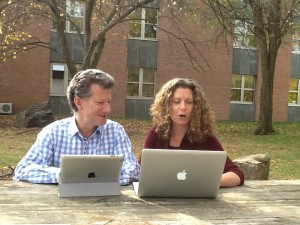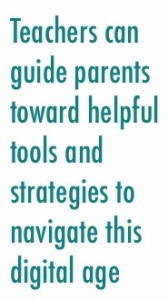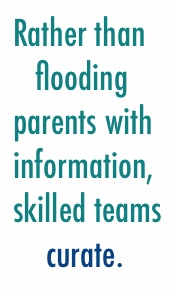
Welcome to our new twice-monthly column highlighting best practices for digital middle schools from a leadership perspective. Twice a month, Tarrant Institute director Penny Bishop and associate director John Downes will share their insight into what they’ve seen make a lasting and profound difference in technology integration with 21st century middle schools.
In this first installment of a 2-part column, they’ll address a critical but often under-addressed component of a successful digital middle school: the family.
As schools adapt to the digital age and integrate Bring Your Own Device (BYOD) programs, interactive whiteboards, handheld devices, and 1:1 computing and learning management systems, classrooms have begun to look less and less like those in which most of today’s parents were educated. Generations of parents have struggled to support their child’s learning; today’s parents face even steeper challenges.
How can educators capitalize on the promise of technology and engage families in new and better ways? What does it mean to increase family engagement in the digital age?
Across the many increasingly hi-tech schools we’ve examined, teachers are answering these questions with exciting new family engagement strategies.
In this installment, we’ll look at two: creating “trans-parent” classrooms, and supplementary guides.
Trans-Parent Classrooms
One team we know is launching a blog to showcase technology-rich work that students post daily from the classroom. The team will ask trusted parents to seed the blog with thoughtful and supportive comments, providing students with a new and respected audience for their schoolwork and modeling constructive and civil online dialog. At the same time, the blog offers families a window into the work of a 21st century team, demystifying the novel opportunities granted by current technologies and sparking rich conversations about technology and learning.
Many t eams use Google Forms or other online survey tools to probe parents about the successes and challenges of 1:1 learning at home. Teams poll families on the relative importance of various parenting issues — monitoring use of social media, encouraging healthy online identities, for instance — and can get instant feedback for analysis and integration into their lesson plans and classroom communities.
eams use Google Forms or other online survey tools to probe parents about the successes and challenges of 1:1 learning at home. Teams poll families on the relative importance of various parenting issues — monitoring use of social media, encouraging healthy online identities, for instance — and can get instant feedback for analysis and integration into their lesson plans and classroom communities.
Much as the middle school movement has encouraged student voice to enhance the relevance of curriculum, teachers can use parent input to inform their family information nights, and the ongoing development of their online parent resources.
Teachers can guide parents toward helpful tools and strategies to navigate this digital age. Team newsletters, portal resources and parent events can all promote family conversations about current issues facing students in their complex online worlds.
Supplementary Guides
Some teachers link parents to ready-made resources like those hosted by Common Sense Media, such as parenting tip sheets or advice videos. But rather than flooding parents with information, skilled teams curate these resources and steer families to those that most directly address their concerns.
Some teams also provide families with templates for home media use agreements that foster parent-child conversations — and ultimately written agreements — about online safety, social media behavior and balancing media use with other a spects of life.
spects of life.
When families participate in take-home 1:1 programs, these agreements can dictate privacy settings, expectations for the “care and feeding” of their school-issued device, and shape when and how long a child can be online. Teams can require that students return a copy of their signed home-use agreement, along with a video interview with the family about their agreement, thereby ensuring these critical conversations take place. They may assign semi-annual updates to the home agreements, pushing families toward ongoing and constructive dialog about technology in family life. These practices acknowledge the powerful influence technology has in homes today, its centrality to powerful learning in and out of school, and the new challenges confronting the vital home-school connection.
Next time: making parents partners in teaching, and the crucial role of volunteering, as our look at 21st century family involvement continues.
—
Penny Bishop is the director of the Tarrant Institute for Innovative Education and a professor of middle-level education in the College of Education and Social Services at UVM. John Downes is the associate director of the Tarrant Institute and a member of the Partnership for Change board.


thanks for post.
that’s a great post.